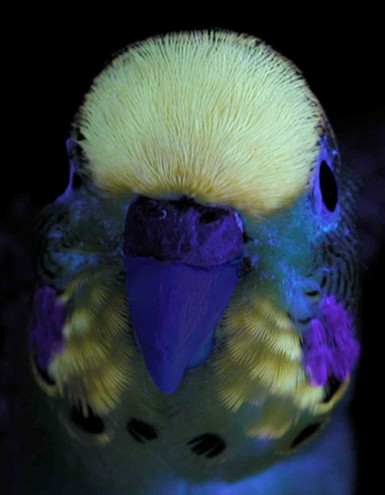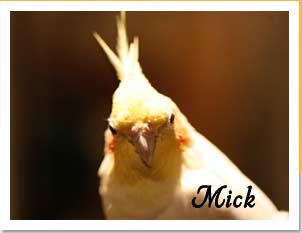Visions of Light: The Importance of Avian Lighting
by John Graziano Birds may be the most visually-oriented animals in nature. They have one of the most sophisticated visual systems, the largest eyes of any animal (relative to body size) and the highest proportion of brain power devoted to vision. They have often been described as "a pair of eyes with wings".
Birds may be the most visually-oriented animals in nature. They have one of the most sophisticated visual systems, the largest eyes of any animal (relative to body size) and the highest proportion of brain power devoted to vision. They have often been described as "a pair of eyes with wings".
Birds' ability to see color far surpasses that of humans, as does their visual acuity and the speed with which they process images. In almost all aspects of the visual experience, birds see a world that we can scarcely imagine.
Yet our companion birds often exist in an environment that is unable to support this spectacular visual machinery. Our human homes are lit for our comparatively unsophisticated eyes, and they often leave our feathered companions … if not "in the dark", then in something relatively close to it.
Standard home lighting is inadequate for several reasons. It is far too dim, has poor color spectrum, is often too red, has little-to-no ultraviolet and is usually placed too low to effectively illuminate a bird's environment. These deficiencies can lead to health and behavior problems such as lethargy (inadequate brightness to fully trigger wakefulness), poor appetite (food may not "look right"), phobias and aggression (difficulty recognizing objects or flock mates), and reproductive behavior (too much red light indicating breeding season).
To address these problems, we need to consider the lighting equipment that our birds evolved under: the sun. While most of us can't realistically offer our birds full access to natural, unfiltered sunlight, many options exist to bring some of the key qualities of the sun into our living areas. We simply need to understand which characteristics of sunlight are most important to our birds' visual experience.
Brightness
The most important aspect of avian lighting is adequate brightness. The lighting that humans use in their homes is often hundreds -- or thousands -- of times dimmer than the tropical sun that our companion birds are used to.

Recent studies have shown that birds require five-to-twenty times the light humans do in order to see in color. In general, this means that birds have severely limited color vision in lighting conditions dimmer than those of a clear sunrise or sunset.
Most human homes are not lit to nearly this brightness level. Standard living room lighting is about eight times dimmer than sunrise or sunset. Even the most brightly-lit rooms in our homes -- the kitchen and bathroom -- are rarely bright enough to fully support avian vision.
To make matters worse, humans are generally poor at noticing differences in brightness. Our eyes quickly adjust to low light conditions, giving us the impression that our indoor lighting is much brighter than it actually is.
Currently, the best solution for providing adequate brightness is fluorescent tubes. These bulbs can greatly increase the brightness of a room with a minimum of cost or electricity use. They also provide a diffuse light source which mimics the general diffuse, bright lighting of a tropical forest.
Spectrum
Birds’ visual ability exceeds ours in many ways, and nowhere is this truer than in the area of color vision. Birds' eyes have four different color receptors compared to our three, giving them an extra dimension of color perception. Each color receptor is also much more precise than ours, and tests have shown that birds are able to distinguish between colors that look identical to humans.
These visual "superpowers" give birds the potential to see billions of colors, whereas human color perception maxes out at around seven million. This makes birds much more sensitive to differences in the color spectrum of light. Lights that seem adequate for human purposes will likely be seen by our avian friends as quite different from natural sunlight.
The accuracy of a light's color spectrum is often expressed in Color Rendering Index (CRI). A perfect CRI is 100, reflecting the color of midday sunlight. Most indoor lighting has CRIs in the 60s and 70s. Even so-called full-spectrum lights can be rated as low as 85 CRI.
At first glance, large windows seem like a great solution to the problem of accurate spectrum. Windows certainly provide the high CRI of minimally-filtered sunlight, but they also present some problems. Large windows can leave birds feeling exposed, adding to their stress levels. Windows may also lead to overheating if a cage is left in direct sun for too long.
Again, fluorescent tube lighting comes to our rescue. Many manufacturers produce specialty fluorescent bulbs that have a rating of 95 CRI or above. These bulbs tend to produce the most accurate and longest-lived color output.
Color Temperature
In lighting, "color temperature" refers to the balance of "hot" and "cool" colors in a light's output. The temperature rating follows the color progression that hot objects exhibit as they start to glow from heat. As an object heats up, it first gives off dull red and then orange. These are examples of lower-temperature colors (note that this is the opposite of the cool/warm ratings that artists use). As an object grows hotter, its light becomes orange, then yellow and finally white and blue. (The flame on a gas stove is a great example of a very hot color spectrum.)
For lighting, color temperature is measured on the Kelvin temperature scale. You'll find ratings of "4700º K" or "6000º K", where the "K" stands for "Kelvin". This does NOT mean that the bulb gives off 6000 degrees of heat! It is simply a convenient way to refer to the hot/cold balance of colors in a light's spectrum.
Our companion birds do best under the color temperature of the sun, which is 5000º K in the tropical latitudes. Color temperatures lower than this (more red) can lead to breeding behavior, while higher color temperatures (more blue) have been shown to produce more stress and feather destruction. For tropical birds, look for a light that has a temperature of at least 5000º K and not more than 5700º K.
Specialty fluorescent tubes like the Philips TL-950 give the best color temperature (5000º K) and have a rating of 98 CRI. These are a great option to provide basic supplemental lighting for your birds.
Ultraviolet Support
In addition to seeing more color detail, birds are also capable of seeing ultraviolet light. They likely perceive UV as an additional set of colors, which combine with the other colors in their visual spectrum. These extra color combinations are what allow birds to see around 200 times the number of colors that humans perceive.
Birds' ultraviolet vision is likely useful in recognizing their flock mates. Most parrots have feathers that reflect UV light, meaning that parrot eyes are likely tuned to notice those reflections. Some parrots may even display sexual dimorphism in their UV coloration.
Birds can also use their UV vision to see the nutrients in their food. This is not unlike humans' ability to detect sugar content simply by looking at the amount of green or yellow in a banana's skin. For birds, their UV-sensitive eyes allow them to see oils, sugars, vitamins, minerals and amino acids that are invisible to us. Without UV light, food may simply not "look right" to birds and may lead to problems with appetite.
Most of our household lighting is well-shielded against UV output. In addition, modern window glass blocks practically all UV. Mix in UV-absorbing interior paint and our living rooms are very UV-poor environments indeed.

Luckily, birds do not need much UV light to support their full vision. Natural sunlight has no more than 0.5% UV content. Also, birds are incapable of seeing the powerful ultraviolet-B light that most reptile bulbs put out, so it is not necessary to use these bulbs to support your bird's vision.
(There's also little evidence that UV-B is useful for generating vitamin D, but that's a topic for another day.)
A small fluorescent tube labeled "black light" should provide enough UV to support your birds' vision. Make sure that it only outputs the lower-energy ultraviolet-A, and try to find a bulb that also puts out some visible light. The Sylvania 21623 or Philips 13036 models are both good choices for UV supplementation.
Placement
Proper positioning of a light source is often an afterthought, but it is one of the most critical considerations when setting up your birds’ lights. Placing a light directly over the cage (or on the cage) can lead to stress as a bird adjusts to a large new object looming over them. Also, placing a light too close to the cage can lead to large differences in light levels in different parts of the cage.
Placing a light too low will also negate many benefits of proper lighting. Food dishes will still be in shadow, as will many toys and cage mates. Also, light coming from below or from the side may defeat a bird's natural eye shading, reducing visual acuity and causing stress. For best results, place your birds’ lights well above the cage and offset from the top. This will give good, consistent illumination without adding a potential new stressor to your birds’ environment.
Summary
As with most parrot-related topics, there is much more to learn and new information is being discovered constantly. But, at present, you can give your birds a decent indoor visual experience using specialty fluorescents like the Philips TL-950, supplemented with a small UV-A bulb like the Sylvania 21623. Make sure that the bulbs are placed in open fixtures (glass or plastic enclosures will ruin the full-spectrum and UV output) mounted above the cage but offset from the top.
One more thing: make sure that any fluorescent fixtures you buy have electronic ballasts. Older, cheaper fixtures use magnetic ballasts, causing an annoying flicker that may lead to stress and feather destruction.
Mickaboo offers a free, three-hour class that covers these topics in much greater detail. These classes are open to the public. You'll learn about light, avian vision, the properties of sunlight and how to select and set up proper lighting for your bird. Look for announcements about future classes at www.mickaboo.org/classes.html (click on the first link in the paragraph about intermediate and advanced classes). The next class is scheduled for April 24, 2 pm at the Walnut Creek Pet Food Express (1388 South California Blvd, Walnut Creek).

